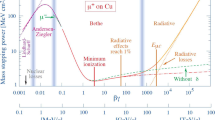Abstract
Purpose
The Jiangmen Underground Neutrino Observatory (JUNO) is designed to determine the neutrino mass ordering and measure neutrino oscillation parameters. A precise muon reconstruction is crucial to reduce one of the major backgrounds induced by cosmic muons.
Methods
This article proposes a novel muon reconstruction method based on convolutional neural network (CNN) models. In this method, the track information reconstructed by the top tracker is used for network training. The training dataset is augmented by applying a rotation to muon tracks to compensate for the limited angular coverage of the top tracker.
Result
The muon reconstruction with the CNN model can produce unbiased tracks with performance that spatial resolution is better than 10 cm and angular resolution is better than 0.6 \({^{\circ }}\). By using a GPU-accelerated implementation, a speedup factor of 100 compared to existing CPU techniques has been demonstrated.











Similar content being viewed by others
References
Z. Djurcic et al., (JUNO Collaboration), arXiv:1508.07166
C. Genster, M. Schever, L. Ludhova, M. Soiron, A. Stahl, C.Wiebusch, https://doi.org/10.1088/1748-0221/13/03/T03003. arXiv:1906.01912
K. Zhang, M. He, W. Li, J. Xu, https://doi.org/10.1007/s41605-018-0040-8. arXiv:1803.10407
O. Russakovsky, J. Deng, H. Su, J. Krause, S. Satheesh, S. Ma et al., arXiv:1409.0575
R. Girshick, J. Donahue, T. Darrell, J. Malik. Rich feature hierarchies for accurate object detection and semantic segmentation, in CVPR (2014)
J. Long, E. Shelhamer, T. Darrell, Fully convolutional networks for semantic segmentation, in CVPR (2015)
G. Kasieczka, T. Plehn, M. Russell, T. Schell, https://doi.org/10.1007/JHEP05(2017)006. arXiv:1701.08784
P. Baldi, K. Bauer, C. Eng, P. Sadowski, D. Whiteson, https://doi.org/10.1103/PhysRevD.93.094034. arXiv:1603.09349
W. Bhimji, S.A. Farrell, T. Kurth, M. Paganini, Prabhat, E. Racah, https://doi.org/10.1088/1742-6596/1085/4/042034. arXiv:1711.03573
A. Aurisano, A. Radovic, D. Rocco, A. Himmel, M.D. Messier, E. Niner, G. Pawloski, F. Psihas, A. Sousa, P. Vahle, https://doi.org/10.1088/1748-0221/11/09/P09001. arXiv:1604.01444
X. Huang et al., offline data processing software for the JUNO experiment, in PoS ICHEP2016 (2017), p. 1051. https://doi.org/10.22323/1.282.1051
T. Lin et al., [JUNO], J. Phys. Conf. Ser. 898(4), 042029 (2017). https://doi.org/10.1088/1742-6596/898/4/042029. arXiv:1702.05275 [physics.ins-det]
J. Allison et al., Recent developments in geant4. NIM A 835, 186–225 (2016). https://doi.org/10.1016/j.nima.2016.06.125
V.A. Kudryavtsev, Comput. Phys. Commun. 180, 339–346 (2009) https://doi.org/10.1016/j.cpc.2008.10.013. arXiv:0810.4635 [physics.comp-ph]
M. Guan, M.C. Chu, J. Cao, K.B. Luk, C. Yang, arXiv:1509.06176
K.K. Pal, K.S. Sudeep, Preprocessing for image classification by convolutional neural networks (IEEE, 2016), pp. 1778–1781. https://doi.org/10.1109/RTEICT.2016.7808140
K. Simonyan, A. Zisserman, Very deep convolutional networks for large-scale image recognition. ICLR 1, 5 (2015)
D. Scherer, A. Muller, S. Behnke, Evaluation of pooling operations in convolutional architectures for object recognition, in Proceedings of the International Conference on Artificial Neural Networks (ICANN), Thessaloniki, Greece, 15–18 September 2010 (Springer, 2010)
E. Phaisangittisagul, An analysis of the regularization between L2 and dropout in single hidden layer neural network (IEEE, 2016), pp. 174–179
M. Abadi, et al., Tensorflow: large-scale machine learning on heterogeneous distributed systems (2015). arXiv:1603.04467
Y. LeCun, L. Bottou, G.B. Orr, K.R. Müller, Neural Networks: Tricks of the Trade (Springer, Berlin, 1998)
X.X. Cao, W.D. Li, R.A. Briere, C.L. Liu, Z.P. Mao, S.J. Chen, Z.Y. Deng, K.L. He, X.T. Huang, B. Huang et al., Chin. Phys. C 34, 1852–1859 (2010). https://doi.org/10.1088/1674-1137/34/12/012
F.H.K. dos Santos Tanaka, C. Aranha. Data augmentation using GANs (2019). arXiv:abs/1904.09135
Author information
Authors and Affiliations
Corresponding author
Additional information
Supported by Strategic Priority Research Program of Chinese Academy of Sciences (XDA10010900) and NSFC (11805223)
Rights and permissions
About this article
Cite this article
Liu, Y., Li, WD., Lin, T. et al. Muon reconstruction with a convolutional neural network in the JUNO detector. Radiat Detect Technol Methods 5, 364–372 (2021). https://doi.org/10.1007/s41605-021-00259-4
Received:
Revised:
Accepted:
Published:
Issue Date:
DOI: https://doi.org/10.1007/s41605-021-00259-4




